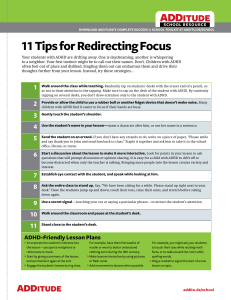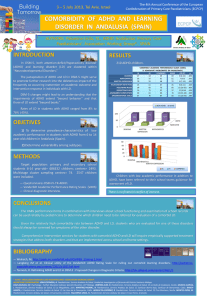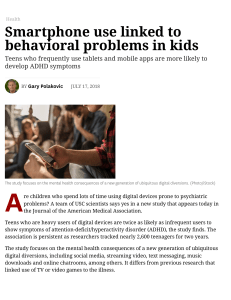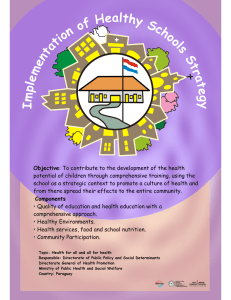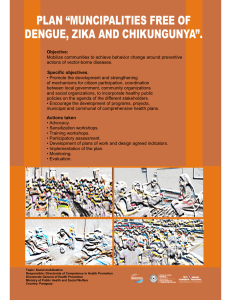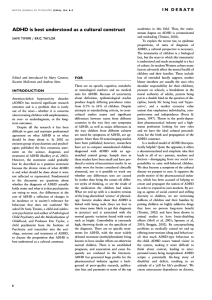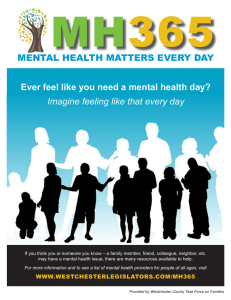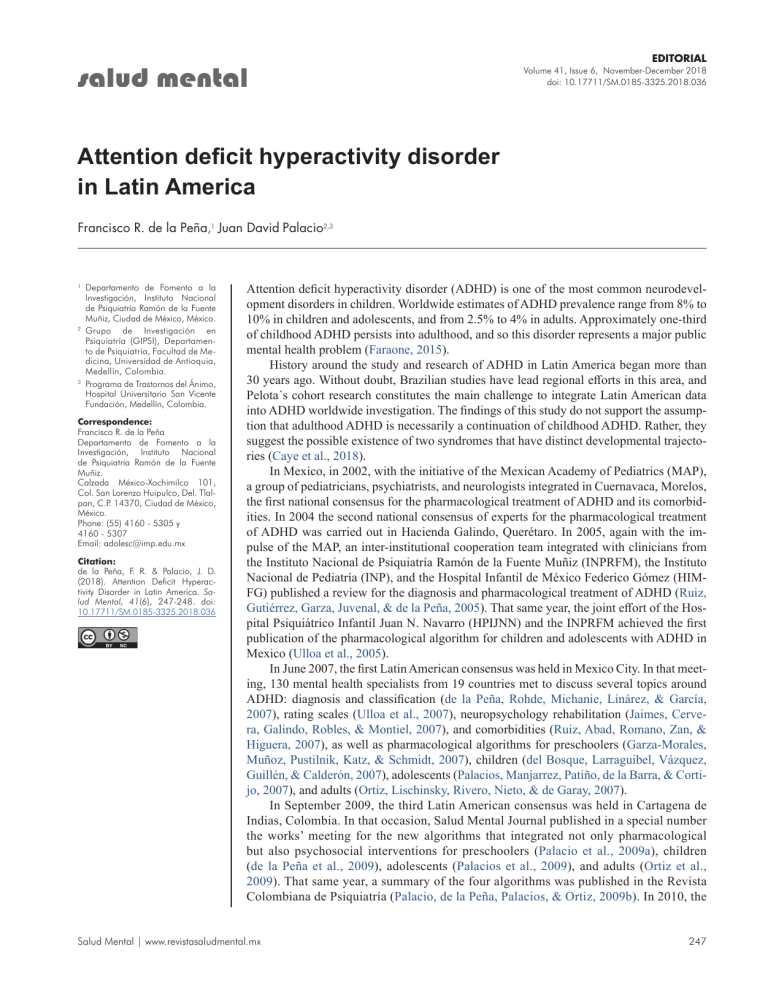
EDITORIAL Volume 41, Issue 6, November-December 2018 doi: 10.17711/SM.0185-3325.2018.036 Attention deficit hyperactivity disorder in Latin America Francisco R. de la Peña,1 Juan David Palacio2,3 1 2 3 Departamento de Fomento a la Investigación, Instituto Nacional de Psiquiatría Ramón de la Fuente Muñiz, Ciudad de México, México. Grupo de Investigación en Psiquiatría (GIPSI), Departamento de Psiquiatría, Facultad de Medicina, Universidad de Antioquia, Medellín, Colombia. Programa de Trastornos del Ánimo, Hospital Universitario San Vicente Fundación, Medellín, Colombia. Correspondence: Francisco R. de la Peña Departamento de Fomento a la Investigación, Instituto Nacional de Psiquiatría Ramón de la Fuente Muñiz. Calzada México-Xochimilco 101, Col. San Lorenzo Huipulco, Del. Tlalpan, C.P. 14370, Ciudad de México, México. Phone: (55) 4160 - 5305 y 4160 - 5307 Email: adolesc@imp.edu.mx Citation: de la Peña, F. R. & Palacio, J. D. (2018). Attention Deficit Hyperactivity Disorder in Latin America. Salud Mental, 41(6), 247-248. doi: 10.17711/SM.0185-3325.2018.036 Attention deficit hyperactivity disorder (ADHD) is one of the most common neurodevelopment disorders in children. Worldwide estimates of ADHD prevalence range from 8% to 10% in children and adolescents, and from 2.5% to 4% in adults. Approximately one-third of childhood ADHD persists into adulthood, and so this disorder represents a major public mental health problem (Faraone, 2015). History around the study and research of ADHD in Latin America began more than 30 years ago. Without doubt, Brazilian studies have lead regional efforts in this area, and Pelota´s cohort research constitutes the main challenge to integrate Latin American data into ADHD worldwide investigation. The findings of this study do not support the assumption that adulthood ADHD is necessarily a continuation of childhood ADHD. Rather, they suggest the possible existence of two syndromes that have distinct developmental trajectories (Caye et al., 2018). In Mexico, in 2002, with the initiative of the Mexican Academy of Pediatrics (MAP), a group of pediatricians, psychiatrists, and neurologists integrated in Cuernavaca, Morelos, the first national consensus for the pharmacological treatment of ADHD and its comorbidities. In 2004 the second national consensus of experts for the pharmacological treatment of ADHD was carried out in Hacienda Galindo, Querétaro. In 2005, again with the impulse of the MAP, an inter-institutional cooperation team integrated with clinicians from the Instituto Nacional de Psiquiatría Ramón de la Fuente Muñiz (INPRFM), the Instituto Nacional de Pediatría (INP), and the Hospital Infantil de México Federico Gómez (HIMFG) published a review for the diagnosis and pharmacological treatment of ADHD (Ruiz, Gutiérrez, Garza, Juvenal, & de la Peña, 2005). That same year, the joint effort of the Hospital Psiquiátrico Infantil Juan N. Navarro (HPIJNN) and the INPRFM achieved the first publication of the pharmacological algorithm for children and adolescents with ADHD in Mexico (Ulloa et al., 2005). In June 2007, the first Latin American consensus was held in Mexico City. In that meeting, 130 mental health specialists from 19 countries met to discuss several topics around ADHD: diagnosis and classification (de la Peña, Rohde, Michanie, Linárez, & García, 2007), rating scales (Ulloa et al., 2007), neuropsychology rehabilitation (Jaimes, Cervera, Galindo, Robles, & Montiel, 2007), and comorbidities (Ruiz, Abad, Romano, Zan, & Higuera, 2007), as well as pharmacological algorithms for preschoolers (Garza-Morales, Muñoz, Pustilnik, Katz, & Schmidt, 2007), children (del Bosque, Larraguibel, Vázquez, Guillén, & Calderón, 2007), adolescents (Palacios, Manjarrez, Patiño, de la Barra, & Cortijo, 2007), and adults (Ortiz, Lischinsky, Rivero, Nieto, & de Garay, 2007). In September 2009, the third Latin American consensus was held in Cartagena de Indias, Colombia. In that occasion, Salud Mental Journal published in a special number the works’ meeting for the new algorithms that integrated not only pharmacological but also psychosocial interventions for preschoolers (Palacio et al., 2009a), children (de la Peña et al., 2009), adolescents (Palacios et al., 2009), and adults (Ortiz et al., 2009). That same year, a summary of the four algorithms was published in the Revista Colombiana de Psiquiatría (Palacio, de la Peña, Palacios, & Ortiz, 2009b). In 2010, the Salud Mental | www.revistasaludmental.mx 247 de la Peña and Palacio Cartagena’s Declaration for ADHD was published; this statement updates scientific information and promotes a campaign against ADHD stigma in society and schools. A draft document was developed before the meeting and reviewed by participants at the consensus. This paper was checked by 26 experts from ten different countries from the region. Twenty-seven points of the statement about clinical, epidemiological, and therapeutic topics were listed, based on the newest scientific evidence for ADHD. The Cartagena Declaration for ADHD was a call that Latin America League for the Study of ADHD members, performed as an organized and multinational group to increase knowledge on the clinical manifestations and treatment of ADHD, and to promote joint efforts and social strategies aimed at reducing the stigma surrounding this disorder (de la Peña, Palacio, & Barragán, 2010). During the period between 2011 and 2017, Salud Mental journal published several other research papers on ADHD. In 2011 an investigation regarding knowledge, beliefs, and attitudes of parents toward ADHD in Mexico was published. In this study, most participants considered ADHD as a disease. It was interesting to note that nearly half of the parents reported that psychologists could make the diagnosis of this condition in a slightly higher number than physicians; in addition, nearly one fifth reported that pediatricians are trained to diagnose ADHD. As far as who is qualified to treat ADHD, more than 40% declared that psychiatrists, followed by psychologists 19.8%, and neurologists 10.4%. Almost two thirds (63%) of the parents reported that the best treatment for ADHD was the combined option, where the psychosocial treatment was considered the most useful intervention. This point highlights the importance of training psychologists as key members in the early diagnosis and treatment of these patients (Palacios et al, 2011). In 2014 the psychosocial adversity, psychopathology, and functioning in high-risk adolescent siblings with and without attention deficit hyperactivity disorder was published. This research found that 45.2% of the siblings had ADHD and they had almost a five-fold probability to present academic dysfunction (OR = 4.3) (Palacios et al., 2014). Now Salud Mental journal once again presents this ADHD special number with regional collaborations of papers from Brazil, Colombia, Chile, and Mexico. The Brazilian team participates with a research in which operationalization and phenomenological heterogeneity in ADHD subjects are studied. In turn, the Colombia team developed a paper in which sleep problems are evaluated in children with ADHD. Chile Team propose a research that evaluates personalities profiles in adolescents with ADHD. Finally, the Mexican teams participate with three topics: Neuropsychological correlates of search behavior in ADHD children; effectiveness and security of lysdexanfetamine in children with ADHD and a comparison of clinical and cognitive characteristics of adults with and without ADHD. All country research team leaders that participate in these pa248 pers, have been close friends, condition that had facilitated collaboration and the participation of young researchers in each team to continue this fraternal and hemmispheric effort to better understand ADHD diagnosis and treatment. REFERENCES del Bosque, J., Larraguibel, M., Vázquez, J. L., Guillén, S., & Calderón, R. (2007). Algoritmo de tratamiento para el trastorno por déficit de atención con hiperactividad en escolares, Psiquiatría, 23, 43-45. Caye, A., Rocha, T. B., Anselmi, L., Murray, J., Menezes, A. M. B., Barros, F. C., ... & Swanson, J. M. (2018). Attention deficit hyperactivity disorder trajectories from childhood to young adulthood. Evidencie from a birth cohor supporting a late-onset syndrome. JAMA Psychiatry, 73(7), 705-712. Faraone, S. V. (2015). Attention deficit hyperactivity disorder and premature death. The Lancet, 385(9983), 2132-2133 Garza-Morales, S., Muñoz, S., Pustilnik, S., Katz, G., & Schmidt, G. (2007). Algoritmo de tratamiento para el trastorno por déficit de atención con hiperactividad en preescolares. Psiquiatría, 23, 40-42. Jaimes, A., Cervera, P., Galindo, G., Robles, E., & Montiel, C. (2007). Rehabilitación neuropsicológica en el trastorno por déficit de atención con hiperactividad. Psiquiatría, 23, 30-32. Ortiz, S., Lischinsky, A., Rivero, L., Nieto, A., & de Garay, B. (2007). Algoritmo de tratamiento en el trastorno por déficit de atención con hiperactividad en el adulto. Psiquiatría, 23, 50-53. Ortiz, S., Lichinsky, A., Rivera, L., Sentíes, H., Grevet, E., & Jaimes, A. (2009). Algoritmo de tratamiento multimodal para adultos latioamericanos con TDAH. Salud Mental, 32(1), S45-S53. Palacio, J. D., Ruiz, M., Bauermaister, J. J., Montiel, C., Henao, G. C., & Agosta, G. (2009a). Algoritmo de Tratamiento Multimodal para Preescolares Latinoamericanos con Trastorno por Déficit de Atención con Hiperactividad (TDAH). Salud Mental, 32(1), 3-16. Palacio, J. D., de la Peña, F. R., Palacios, L., & Ortiz, S. (2009b). Algoritmo latinoamericano de tratamiento multimodal del TDAH a través de la vida. Revista Colombiana de Psiquiatría, 39(1), 35S-65S. Palacios, L., Manjarrez, L., Patiño, R., de la Barra, F., & Cortijo, A. (2007). Algoritmo de tratamiento farmacológico para el adolescente con trastorno por déficit de atención con hiperactividad. Psiquiatría, 23, 46-49. Palacios, L., Zavaleta, P., Patiño, R., Abadi, A., Díaz, D., Taddey, N., … & Sosa, L. (2009). Algoritmo de Tratamiento Multimodal para Adolescentes Latinoamericanos con Trastorno por Déficit de Atención con Hiperactividad (TDAH). Salud Mental, 32(1), S31-S44. Palacios, L., de la Peña, F. R., Valderrama, A., Patiño, R., Calle, S. P., & Ulloa, R. E. (2011). Conocimiento, creencias y actitudes en padres mexicanos acerca del TDAH. Salud Mental, 34(2), 149-155. Palacios, L., Arias-Caballero, A., Ulloa, R. E., González-Reyna, N., Mayer, P., Feria, M., … & Benjet, C. (2014). Psychosocial adversity, psychopathology, and functioning in high-risk adolescent siblings with and without attention deficit hyperactivity disorder (ADHD). Salud Mental, 37, 467-476. de la Peña, F., Rohde, L., Michanie, C., Linárez, R., & García, R. (2007). Diagnóstico y clasificación del trastorno por déficit de atención con hiperactividad. Psiquiatría, 23, 5-8. de la Peña, F. R., Barragán, E., Rohde, L. A., Patiño, L. R., Zavaleta, P., Ulloa. R. E., ... & Larraguibel, M. (2009). Algoritmo de Tratamiento Multimodal para Escolares Latinoamericanos con Trastorno por Déficit de Atención con Hiperactividad (TDAH). Salud Mental, 32(1), S17-S29. de la Peña, F. R., Palacio, J. D., & Barragán, E. (2010). Declaración de Cartagena para el TDAH: Rompiendo el Estigma. Revista Ciencias de la Salud, 8(1), 95-100. Ruiz, M., Gutiérrez, J., Garza, S., Juvenal, S., & de la Peña, F. (2005). Trastorno por déficit de atención con hiperactividad, actualidades diagnósticas y terapéuticas. Boletín médico del Hospital Infantil de México, 62(2), 145-152. Ruiz, M., Abad, A., Romano, P., Zan, F., & Higuera, F. (2007). Comorbilidades en el trastorno por déficit de atención con hiperactividad: Diagnóstico y tratamiento. Psiquiatría, 23, 37-39. Ulloa, R. E., Arroyo, E., Avila, J. M., Cárdenas, J. A., Cruz, E., & de la Peña, F. (2005). Algoritmo del tratamiento para el trastorno por déficit de atención e hiperactividad en niños y adolescentes. Salud Mental, 28(5), 1-10. Ulloa, R. E., Taddey, N., Meza, A., Padrón, E., & Remedi, C. (2007). La clinimetría en el trastorno por déficit de atención con hiperactividad. Psiquiatría, 23, 9-16. Salud Mental, Vol. 41, Issue 6, November-December 2018
